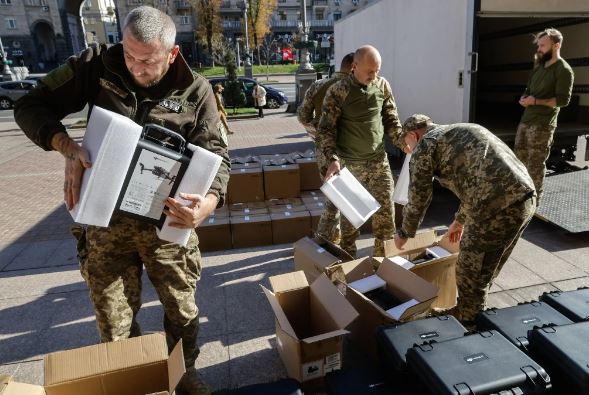The United States has agreed to provide Ukraine with $800 million in military aid to produce long-range drones domestically, marking a shift in Washington’s approach to arming Kyiv against Russian forces. This funding represents a major milestone for Ukraine, fulfilling President Volodymyr Zelensky’s long-term objective of securing U.S. support for domestic weapons manufacturing rather than relying solely on American-produced arms.
A Pentagon official, who spoke anonymously due to the sensitivity of the matter, confirmed this shift in policy. The United States is now prioritizing Ukraine’s ability to strengthen its own defense industry and fight the war with its own resources. While this is a significant step, it also reflects broader changes in U.S. strategy, likely influenced by dwindling Pentagon stockpiles and concerns about ongoing conflicts.
President Zelensky, speaking to journalists on Monday, emphasized that the $800 million disbursement is just the beginning of U.S. support for Ukraine’s domestic weapons production. This aid is aimed at enhancing Kyiv’s long-range capabilities, particularly through drone technology, a key component of Ukraine’s current military strategy.
While the U.S. has consistently rejected Ukraine’s appeals to lift restrictions on the use of long-range Western missiles for strikes deep into Russian territory, this latest move indicates a more flexible approach in supporting Ukraine’s defense efforts. The development of drones that can strike far-reaching targets gives Ukraine a critical advantage, especially as it continues to face relentless Russian attacks in the eastern part of the country.
Since the start of the Russian invasion in February 2022, the United States has contributed over $61 billion in security aid to Ukraine. However, this is the first time U.S. funding will be directed toward Ukraine’s domestic weapons manufacturing industry. Previously, U.S. military aid focused primarily on supporting American defense contractors, partly to minimize the potential for corruption in Ukraine and ensure efficient use of resources.
This change in U.S. policy comes after other nations joined Ukraine’s efforts to develop its own defense industry. Denmark was the first country to support Ukraine’s Manufacturing Freedom campaign, which aims to raise $10 billion for Ukrainian weapons production. Denmark committed $28.5 million to buy weapons from Ukrainian manufacturers, followed by Canada and the Netherlands.
For Ukraine, this aid is particularly crucial as the war drags on and Russian forces continue to occupy about 20% of the country. Despite heavy casualties on the Russian side, with over 1,200 troops reported killed daily in September, Moscow’s military presence remains formidable. President Zelensky has spent weeks promoting what he calls a “victory plan” to his Western allies, urging them to increase their military support for Ukraine.
While no country has fully committed to Zelensky’s proposed plan, which would rely on sustained Western military aid, the U.S. move to fund Ukrainian drone production is seen as a significant step toward empowering Ukraine to wage the war on its own terms. Zelensky noted that Western allies, including the U.S. and Germany, remain cautious about granting Ukraine NATO membership, despite strong support from other NATO members.
Drones have become a vital component of Ukraine’s defense strategy, allowing Kyiv to target Russian facilities far beyond the frontlines. Ukraine’s Defense Minister, Rustem Umerov, said on Monday that Ukraine has invested more than $4 billion in its defense industry, with long-range drones being a key focus. These drones are capable of hitting targets over 1,000 miles away and have destroyed more than 200 military facilities inside Russia.
“Our drones have become a real threat to the enemy,” Umerov stated, while urging continued investment from international partners. Recent Ukrainian drone strikes on Russian ammunition depots in September, particularly near the town of Toropets, have been praised by Western officials. These strikes destroyed an estimated 100,000 tons of Russian and North Korean-supplied ammunition — the largest loss of such supplies since the war began.
U.S. Defense Secretary Lloyd Austin also highlighted the effectiveness of Ukraine’s drone capabilities, noting that the cost of producing these drones is significantly lower than that of precision-guided missiles. Austin emphasized that the drones have proven both accurate and impactful on the battlefield, providing Ukraine with a strategic advantage.
As Ukraine continues to battle Russian forces, the shift toward domestic weapons production and the growing importance of drone technology reflect the evolving nature of the conflict and the ongoing efforts to secure Ukraine’s future both on and off the battlefield.

